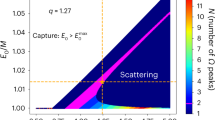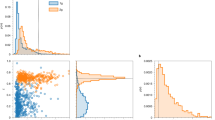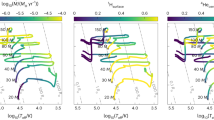Abstract
The merger of two massive (about 30 solar masses) black holes has been detected in gravitational waves1. This discovery validates recent predictions2,3,4 that massive binary black holes would constitute the first detection. Previous calculations, however, have not sampled the relevant binary-black-hole progenitors—massive, low-metallicity binary stars—with sufficient accuracy nor included sufficiently realistic physics to enable robust predictions to better than several orders of magnitude5,6,7,8,9,10. Here we report high-precision numerical simulations of the formation of binary black holes via the evolution of isolated binary stars, providing a framework within which to interpret the first gravitational-wave source, GW150914, and to predict the properties of subsequent binary-black-hole gravitational-wave events. Our models imply that these events form in an environment in which the metallicity is less than ten per cent of solar metallicity, and involve stars with initial masses of 40–100 solar masses that interact through mass transfer and a common-envelope phase. These progenitor stars probably formed either about 2 billion years or, with a smaller probability, 11 billion years after the Big Bang. Most binary black holes form without supernova explosions, and their spins are nearly unchanged since birth, but do not have to be parallel. The classical field formation of binary black holes we propose, with low natal kicks (the velocity of the black hole at birth) and restricted common-envelope evolution, produces approximately 40 times more binary-black-holes mergers than do dynamical formation channels involving globular clusters11; our predicted detection rate of these mergers is comparable to that from homogeneous evolution channels12,13,14,15. Our calculations predict detections of about 1,000 black-hole mergers per year with total masses of 20–80 solar masses once second-generation ground-based gravitational-wave observatories reach full sensitivity.
This is a preview of subscription content, access via your institution
Access options
Subscribe to this journal
Receive 51 print issues and online access
$199.00 per year
only $3.90 per issue
Buy this article
- Purchase on Springer Link
- Instant access to full article PDF
Prices may be subject to local taxes which are calculated during checkout



Similar content being viewed by others
References
Abbott, B. P. et al. Observation of gravitational waves from a binary black hole merger. Phys. Rev. Lett. 116, 061102 (2016)
Belczynski, K. et al. The effect of metallicity on the detection prospects for gravitational waves. Astrophys. J. 715, L138–L141 (2010)
Dominik, M. et al. Double compact objects. III. Gravitational-wave detection rates. Astrophys. J. 806, 263 (2015)
Belczynski, K. et al. Compact binary merger rates: comparison with LIGO/Virgo upper limits. Astrophys. J. 819, 108 (2016)
Tutukov, A. V. & Yungelson, L. R. The merger rate of neutron star and black hole binaries. Mon. Not. R. Astron. Soc. 260, 675–678 (1993)
Lipunov, V. M., Postnov, K. A. & Prokhorov, M. E. Black holes and gravitational waves: possibilities for simultaneous detection using first-generation laser interferometers. Astron. Lett. 23, 492–497 (1997)
Nelemans, G., Yungelson, L. R. & Portegies Zwart, S. F. The gravitational wave signal from the Galactic disk population of binaries containing two compact objects. Astron. Astrophys. 375, 890–898 (2001)
Voss, R. & Tauris, T. M. Galactic distribution of merging neutron stars and black holes – prospects for short gamma-ray burst progenitors and LIGO/VIRGO. Mon. Not. R. Astron. Soc. 342, 1169–1184 (2003)
Belczynski, K., Taam, R. E., Kalogera, V., Rasio, F. A. & Bulik, T. On the rarity of double black hole binaries: consequences for gravitational wave detection. Astrophys. J. 662, 504–511 (2007)
Mennekens, N. & Vanbeveren, D. Massive double compact object mergers: gravitational wave sources and r-process element production sites. Astron. Astrophys. 564, A134 (2014)
Rodriguez, C. L., Chatterjee, S. & Rasio, F. A. Binary black hole mergers from globular clusters: masses, merger rates, and the impact of stellar evolution. Phys. Rev. D 93, 084029 (2016)
Marchant, P., Langer, N., Podsiadlowski, P., Tauris, T. M. & Moriya, T. J. A new route towards merging massive black holes. Astron. Astrophys. 588, A50 (2016)
de Mink, S. E. & Mandel, I. The chemically homogeneous evolutionary channel for binary black hole mergers: rates and properties of gravitational-wave events detectable by advanced LIGO. Mon. Not. R. Astron. Soc. http://dx.doi.org/10.1093/mnras/stw1219 (2016)
Eldridge, J. J. & Stanway, E. R. BPASS predictions for Binary Black-Hole Mergers. Preprint at http://arxiv.org/abs/1602.03790 (2016)
Woosley, S. E. The progenitor of GW150914. Preprint at http://arXiv.org/abs/1603.00511 (2016)
Belczynski, K., Kalogera, V. & Bulik, T. A comprehensive study of binary compact objects as gravitational wave sources: evolutionary channels, rates, and physical properties. Astrophys. J. 572, 407–431 (2002)
Belczynski, K. et al. Compact object modeling with the StarTrack population synthesis code. Astrophys. J. Suppl. Ser. 174, 223–260 (2008)
Fryer, C. L. et al. Compact remnant mass function: dependence on the explosion mechanism and metallicity. Astrophys. J. 749, 91 (2012)
Bulik, T., Belczynski, K. & Prestwich, A. IC10 X-1/NGC300 X-1: the very immediate progenitors of BH-BH binaries. Astrophys. J. 730, 140 (2011)
Hirschauer, A. S. et al. ALFALFA discovery of the most metal-poor gas-rich galaxy known: AGC 198691. Astrophys. J. 822, 108 (2016)
Bulik, T., Gondek-Rosinska, D. & Belczynski, K. Expected masses of merging compact object binaries observed in gravitational waves. Mon. Not. R. Astron. Soc. 352, 1372–1380 (2004)
Abbott, B. P. et al. The rate of binary black hole mergers inferred from advanced LIGO observations surrounding GW150914. Preprint at http://arxiv.org/abs/1602.03842 (2016)
Pavlovskii, K. & Ivanova, N. Mass transfer from giant donors. Mon. Not. R. Astron. Soc. 449, 4415–4427 (2015)
Eldridge, J. J., Fraser, M., Smartt, S. J., Maund, J. R. & Crockett, R. M. The death of massive stars – II. Observational constraints on the progenitors of Type Ibc supernovae. Mon. Not. R. Astron. Soc. 436, 774–795 (2013)
Gerke, J. R., Kochanek, C. S. & Stanek, K. Z. The search for failed supernovae with the Large Binocular Telescope: first candidates. Mon. Not. R. Astron. Soc. 450, 3289–3305 (2015)
Ricker, P. M. & Taam, R. E. The interaction of stellar objects within a common envelope. Astrophys. J. 672, L41–L44 (2008)
MacLeod, M. & Ramirez-Ruiz, E. Asymmetric accretion flows within a common envelope. Astrophys. J. 803, 41 (2015)
Rogers, T. M., Lin, D. N. C., McElwaine, J. N. & Lau, H. H. B. Internal gravity waves in massive stars: angular momentum transport. Astrophys. J. 772, 21 (2013)
Albrecht, S. et al. The BANANA project. V. Misaligned and precessing stellar rotation axes in CV Velorum. Astrophys. J. 785, 83 (2014)
Dominik, M. et al. Double compact objects. I. The significance of the common envelope on merger rates. Astrophys. J. 759, 52 (2012)
Xu, X.-J. & Li, X.-D. Erratum: “On the binding energy parameter λ of common envelope evolution” (2010, ApJ, 716, 114). Astrophys. J. 722, 1985–1988 (2010)
Belczynski, K., Wiktorowicz, G., Fryer, C. L., Holz, D. E. & Kalogera, V. Missing black holes unveil the supernova explosion mechanism. Astrophys. J. 757, 91 (2012)
Hurley, J. R., Pols, O. R. & Tout, C. A. Comprehensive analytic formulae for stellar evolution as a function of mass and metallicity. Mon. Not. R. Astron. Soc. 315, 543–569 (2000)
Vink, J. S. The theory of stellar winds. Astrophys. Space Sci. 336, 163–167 (2011)
Podsiadlowski, P., Joss, P. C. & Hsu, J. J. L. Presupernova evolution in massive interacting binaries. Astrophys. J. 391, 246–264 (1992)
Ivanova, N. et al. Common envelope evolution: where we stand and how we can move forward. Astron. Astrophys. Rev. 21, 59 (2013)
Hobbs, G., Lorimer, D. R., Lyne, A. G. & Kramer, M. A statistical study of 233 pulsar proper motions. Mon. Not. R. Astron. Soc. 360, 974–992 (2005)
Szécsi, D. et al. Low-metallicity massive single stars with rotation. Evolutionary models applicable to I Zwicky 18. Astron. Astrophys. 581, A15 (2015)
Sana, H. et al. Binary interaction dominates the evolution of massive stars. Science 337, 444–446 (2012)
Bastian, N., Covey, K. R. & Meyer, M. R. A universal stellar initial mass function? A critical look at variations. Annu. Rev. Astron. Astrophys. 48, 339–389 (2010)
Dominik, M. et al. Double compact objects. II. Cosmological merger rates. Astrophys. J. 779, 72 (2013)
de Mink, S. E. & Belczynski, K. Merger rates of double neutron stars and stellar origin black holes: the impact of initial conditions on binary evolution predictions. Astrophys. J. 814, 58 (2015)
Duchêne, G. & Kraus, A. Stellar multiplicity. Annu. Rev. Astron. Astrophys. 51, 269–310 (2013)
Madau, P. & Dickinson, M. Cosmic star-formation history. Annu. Rev. Astron. Astrophys. 52, 415–486 (2014)
Strolger, L.-G. et al. The Hubble Higher z Supernova Search: supernovae to z ≈ 1.6 and constraints on Type Ia progenitor models. Astrophys. J. 613, 200–223 (2004)
Vangioni, E. et al. The impact of star formation and gamma-ray burst rates at high redshift on cosmic chemical evolution and reionization. Mon. Not. R. Astron. Soc. 447, 2575–2587 (2015)
Dvorkin, I., Silk, J., Vangioni, E., Petitjean, P. & Olive, K. A. The origin of dispersion in DLA metallicities. Mon. Not. R. Astron. Soc. 452, L36–L40 (2015)
Almeida, L. A. et al. Discovery of the massive overcontact binary VFTS 352: evidence for enhanced internal mixing. Astrophys. J. 812, 102 (2015)
O’Shaughnessy, R., Kalogera, V. & Belczynski, K. Mapping population synthesis event rates on model parameters. II. Convergence and accuracy of multidimensional fits. Astrophys. J. 667, 1048–1058 (2007)
Abbott, B. P. et al. Astrophysical implications of the binary black hole merger GW150914. Astrophys. J. 818, L22 (2016)
Spera, M., Mapelli, M. & Bressan, A. The mass spectrum of compact remnants from the PARSEC stellar evolution tracks. Mon. Not. R. Astron. Soc. 451, 4086–4103 (2015)
Khan, S. et al. Frequency-domain gravitational waves from nonprecessing black-hole binaries. II. A phenomenological model for the advanced detector era. Phys. Rev. D 93, 044007 (2016)
Husa, S. et al. Frequency-domain gravitational waves from nonprecessing black-hole binaries. I. New numerical waveforms and anatomy of the signal. Phys. Rev. D 93, 044006 (2016)
Abbott, B. P. et al. Prospects for observing and localizing gravitational-wave transients with Advanced LIGO and Advanced Virgo. Living Rev. Relativ. 19, 1 (2013)
Villante, F. L., Serenelli, A. M., Delahaye, F. & Pinsonneault, M. H. The chemical composition of the sun from helioseismic and solar neutrino data. Astrophys. J. 787, 13 (2014)
Acknowledgements
We are indebted to G. Wiktorowicz, W. Gladysz and K. Piszczek for their help with population synthesis calculations, and to H.-Y. Chen and Z. Doctor for their help with our LIGO/Virgo rate calculations. We thank the thousands of Universe@home users that have provided their personal computers for our simulations. We also thank the Hannover GW group for letting us use their ATLAS supercomputer. K.B. acknowledges support from the NCN grant Sonata Bis 2 (DEC-2012/07/E/ST9/01360). D.E.H. was supported by NSF CAREER grant PHY-1151836. D.E.H. also acknowledges support from the Kavli Institute for Cosmological Physics at the University of Chicago through NSF grant PHY-1125897 as well as an endowment from the Kavli Foundation. T.B. acknowledges support from the NCN grant Harmonia 6 (UMO-2014/14/M/ST9/00707). R.O’S. was supported by NSF grant PHY-1505629.
Author information
Authors and Affiliations
Contributions
All authors contributed to the analysis and writing of the paper.
Corresponding author
Ethics declarations
Competing interests
The authors declare no competing financial interests.
Additional information
Reviewer Information Nature thanks M. Cantiello and the other anonymous reviewer(s) for their contribution to the peer review of this work.
Extended data figures and tables
Extended Data Figure 1 Maximum total mass of BH–BH mergers as a function of metallicity.
Binary stars at metallicities Z < 0.1Z⊙ can form BH–BH mergers that are more massive than Mtot = 64.8M⊙. This suggests that GW150914 was formed in a low-metallicity environment, assuming it is a product of classical isolated binary evolution. The total binary-maximum BH–BH mass is not a simple sum of maximum BH masses resulting from single stellar evolution; this is a result of mass loss during the RLOF and CE evolution phases in the formation of massive BH–BH mergers (Fig. 1).
Extended Data Figure 2 Emergence of a bimodal birth-time distribution.
a, BH binaries follow an intrinsic power-law delay-time distribution (proportional to t−1). The birth time (tbirth = tmerger − tdelay) is inverted compared to the delay-time distribution (blue line), with the spread caused by allowing the merger time (tmerger) to fall anywhere within the O1 LIGO horizon: z = 0–0.7; this generates a peak corresponding to BH–BH progenitors born late with short delay times. b, Massive BH–BH binaries are formed by only low-metallicity stars (Z < 0.10Z⊙). The fraction of all stars that form at such low Z (FZ) decreases with cosmic time, making low-Z star formation (in units of M⊙ Mpc−3 yr−1) peak at early cosmic time. sfr, star-formation rate. c, The final birth-time distribution for massive BH–BH mergers is a convolution of the intrinsic birth times and the low-metallicity star-formation rate.
Extended Data Figure 3 Predicted distribution of BH–BH merger mass ratios.
dRdet/dq is the contribution to the detection rate, Rdet, from binaries within a given 0.02 bin in mass ratio, q. Standard model (M1) detector-frame mass ratio is shown. BH–BH binaries prefer mass ratios of q ≳ 0.7, with a prominent peak near comparable-mass systems. GW150914, with  (90% credible range) and a total redshifted mass of Mtot,z = 70.5M⊙, falls within the expected region.
(90% credible range) and a total redshifted mass of Mtot,z = 70.5M⊙, falls within the expected region.
Extended Data Figure 4 Source-frame merger-rate density for BH–BH binaries as a function of redshift.
The red line shows the results from our standard model (M1); in this model, massive BHs do not get natal kicks. A sequence of models with increasing BH natal kicks (models M6, M5, M4, M3) is shown. The rate density decreases with increasing natal kick strength described by a Maxwellian distribution with a one-dimensional root mean square deviation of σ. The local merger-rate density (z < 0.1) changes from 218 Gpc−3 yr−1 (M1) to 63 Gpc−3 yr−1 (M6), 25 Gpc−3 yr−1 (M5), 11 Gpc−3 yr−1 (M4) and 6.6 Gpc−3 yr−1 (M3). The LIGO estimate (2–400 Gpc−3 yr−1) encompasses all of these models. We mark the O1 LIGO detection horizon (z = 0.7; see Extended Data Fig. 7).
Extended Data Figure 5 BH mass as a function of initial star mass, for a range of metallicities.
These results show calculations for single star evolution with no binary interactions. Our updated models of BH formation show a general increase of BH mass with initial progenitor star mass. There is strong dependence of BH mass on the chemical composition of the progenitor. For example, the maximum BH mass increases from 10M⊙–15M⊙ for high-metallicity progenitors (Z = 1.5Z⊙–1Z⊙) to 94M⊙ for low-metallicity progenitors (Z = 0.005Z⊙). The formation of a single 30M⊙ BH requires a metallicity of Z ≤ 0.25Z⊙. ZAMS, zero-ago main sequence.
Extended Data Figure 6 Mean-metallicity evolution of the Universe with redshift.
It is assumed that at each redshift the metallicity distribution is log-normal with a standard deviation of σ = 0.5 dex. The blue line denotes the mean-metallicity evolution adopted in previous studies. The new relation generates more low-metallicity stars at all redshifts. We mark the line above which we can make predictions (log(Z/Z⊙) = −2.3, Z⊙ = 0.02; ref. 55) based on actual evolutionary stellar models adopted in our calculations. Below this line we assume that stars produce BH–BH mergers in the same way as in the case of our lowest available model.
Extended Data Figure 7 Horizon redshift for the first advanced LIGO observational run (O1).
Horizon is given as a function of the total redshifted binary merger mass (assuming equal-mass mergers). For the highest-mass mergers found in our simulations (Mtot,z = 240M⊙), the horizon redshift is zhor = 0.7. For GW150914 (Mtot,z = 70.5M⊙), the horizon redshift is zhor = 0.36.
Rights and permissions
About this article
Cite this article
Belczynski, K., Holz, D., Bulik, T. et al. The first gravitational-wave source from the isolated evolution of two stars in the 40–100 solar mass range. Nature 534, 512–515 (2016). https://doi.org/10.1038/nature18322
Received:
Accepted:
Published:
Issue Date:
DOI: https://doi.org/10.1038/nature18322
This article is cited by
-
Contribution of population III stars to merging binary black holes
Reviews of Modern Plasma Physics (2024)
-
Simulations of common-envelope evolution in binary stellar systems: physical models and numerical techniques
Living Reviews in Computational Astrophysics (2023)
-
Reconstruction of power spectrum of primordial curvature perturbations on small scales from primordial black hole binaries scenario of LIGO/VIRGO detection
Science China Physics, Mechanics & Astronomy (2023)
Comments
By submitting a comment you agree to abide by our Terms and Community Guidelines. If you find something abusive or that does not comply with our terms or guidelines please flag it as inappropriate.



